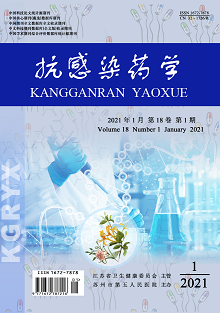QIAO Jin, ZHU Li-cheng, ZHAO Yan
Objective: To analyze on efficacy of SAN'AO tablets combined with salmeterol/fluticasone propionate in patients with cough variant asthma (CVA) and its influence on immune function, lung function and inflammatory factors on improvement. Methods: Clinical data of 86 CVA patients in the Department of Respiratory Medicine from January 2018 to June 2019 were selected and divided into observation group and control group based on different therapeutic drugs, with 43 patients in each group. Patients in the observation group were given oral administration of SAN'AO tablet and salmeterol/fluticasone propionate, while patients in the control group were given salmeterol/fluticasone propionate only. The differences in clinical efficacy, incidence of adverse drug reactions and recurrence rate, and the changes in cough symptom scores, lung function (FEV1, FVC and FEVl/FVC), immune function (CD3, CD4 and CD4/CD8), serum inflammatory factors (IgE, TNF-alpha, IL-4 and IL-6) before and after 4 weeks of treatment were compared between the two groups. Results: After 4 weeks, the total effective rate in the observation group was higher than that in the control group (97.67% vs 74.42%, P<0.05). Compared with that before treatment, the scores of cough symptoms in both groups were significantly lower after treatment (P<0.05), but the scores of cough symptoms in the observation group were significantly lower than those in the control group (P<0.05). After treatment, the levels of lung function (FEV1, FVC and FEVl/FVC) in the observation group were significantly higher than those in the control group (P<0.05), and the levels of immune function (CD3, CD4 and CD4/CD8) were significantly higher than those in the control group (P<0.05). After treatment, serum levels of inflammatory factors (IgE, TNF-alpha, IL-4 and IL-6) were all lower than those before treatment, but the observation group was significantly lower than the control group (P<0.05). After 4 weeks of treatment, the recurrence rate of patients in the observation group was significantly lower than that in the control group (11.63% vs 30.23%, P<0.05). There was no statistically significant difference in the incidence of adverse drug reactions between the two groups (P>0.05). Conclusion: Patients with CVA were treated using inhalation of San'ao tablet and salmeterol/fluticasone propionate can effectively improve symptoms of cough, immune function and lung function in patients with CVA, reduce the serum IgE, TNF-alpha, IL-6 and IL-4 levels, its curative effect is better than that of salmeterol/ fluticasone propionate alone medication, effectively improve the clinical efficacy, and the safety of medication is higher.
